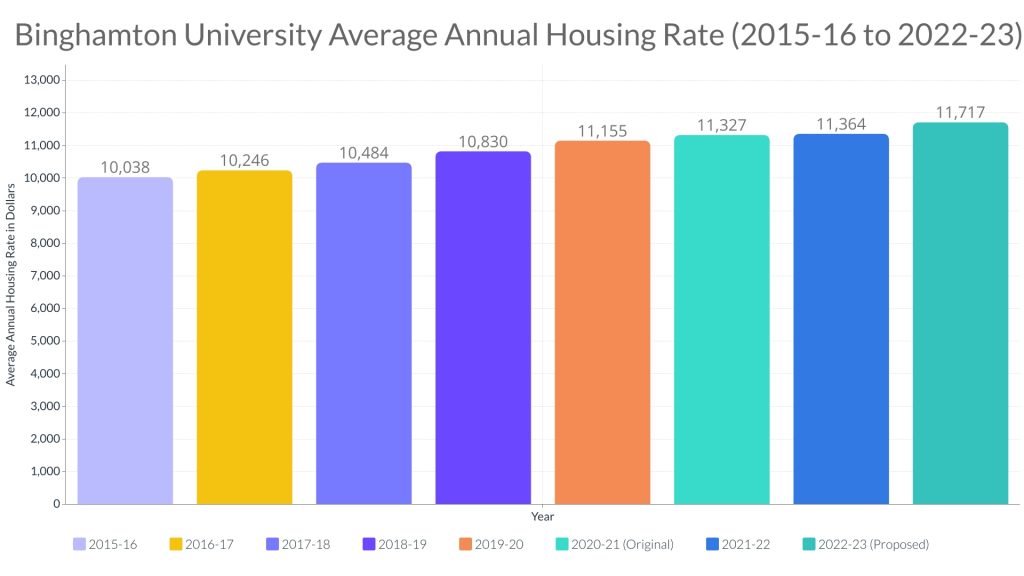For the seventh year in a row, Binghamton University Residential Life will be increasing housing rates across the campus.
Proposed housing rates for the 2022-23 academic year will see an increase of 3.11 percent from this current academic year in terms of the average annual housing rate. This increase will be the largest since the 2018-19 academic year, which saw a 3.30 percent increase in the average annual housing rate from the previous year.
Over the past seven years, the average annual housing rate has increased from $10,037.57 in 2015-16 to a proposed $11,717.25 for 2022-23. In total, this is an increase of 16.7 percent.
Paola Mignone, ‘21, the assistant vice president for residential experiences, explained the process that decides housing rates and increases.
“Every year the University goes through a process to determine the room rates for the following year,” Mignone wrote in an email. “In addition to a committee of all of the administrative areas that are involved in operating and maintaining the residence halls, the process also includes consultation with the residential community governments and councils. After the committee reviews a proposal with the community governments, final rate approval passes through the committee to the vice president for student affairs, the chief financial officer and then the president.”
Mignone said the process entails reviews of costs and expenses such as debt, maintenance, employee salaries, investments for future renovations and developments and others. For this coming year, Mignone said such cost increases have triggered rate increases.
“Unfortunately, many of our costs are increasing,” Mignone wrote. “Utility expenses are up 20 [percent], unionized employees are due salary increases by state contract and the price of most furniture and equipment has significantly increased with inflation. Those increased costs typically influence a rate increase. We also consider what has happened to rates over time. If the cumulative rate increase over the last few years is getting high, we may not increase the rate as much as expenses increased, but instead delay a major repair (e.g. roof replacement) or a building renovation.”
This past April saw state union agreement expire for the Administrative Services Unit and the Operational Services Unit, both of which contain the majority of the employees hired by Residential Life. A press release put out in November by the Civil Service Employees Association (CSEA), which represents both units in negotiations, indicated that after a COVID-19-related delay, the units were ready for negotiations.
When comparing this academic year and the next academic year rates, increases vary between the buildings. Mignone said various differences in the buildings determine the different increases.
“The residence halls are different from community to community and sometimes from building to building,” Mignone wrote. “Generally newer and/or better equipped buildings have higher rates than older buildings. That is why rate increases are not uniform across the board. If a particular hall has been newly renovated, that hall may have a higher price increase than a not renovated hall.”
Aside from the 12.1 percent increase in prices of Hillside Community and Susquehanna Community, largely due to the reintroduction of the “family” unit next year, the largest average community-specific annual rate increase can be found in Hinman College, with an increase of 6.57 percent.
In regard to student reception about the rate increases, Briana Lopez-Patino, a junior majoring in philosophy, said on-campus housing rates will affect the local community.
“Considering we are a public university, our housing rates should not be more expensive than a private university,” Lopez-Patino wrote. “The cheapest housing option at [BU] is a designed triple in [College-in-the-Woods] for $5,037/semester, while the cheapest housing option at Syracuse University is an open triple for $3,610/semester. The higher rates are motivating students to live off campus, which creates a larger issue for the local population of Binghamton since students are taking over the local real estate.”
Trevor Fornara, a junior majoring in philosophy, politics and law, compared the price and value of off-campus housing with that of on-campus housing.
“This is my second year in Mountainview [College], and I pay $11,252 annually to live here for eight months of the year, not including meal plan,” Fornara wrote. “Monthly, that’s $1,406 per person for eight months. Two of my roommates and I signed a lease for the first floor of a house on the West Side of Binghamton for $1,650 a month for twelve months. The monthly rate divided between the three of us is only $550 per person. We’ll have off-street parking, control over the thermostat and the personal freedom that cannot be afforded in a rule-laden dormitory. The school is moving on-campus housing prices in the wrong direction.”



